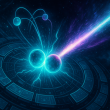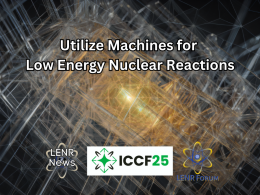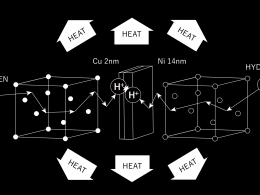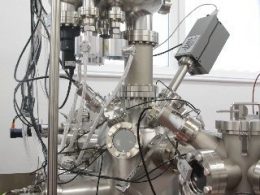Author: LeBob/Bob Dash on LENR Forum/Disqus
Fusion in a bottle. A metered sun in a large microwave, dorm fridge, toaster oven-sized device, or domestic water heater-sized device. Many expect the answer to look, feel, and work as described here. It doesn’t yet; most researchers, experimenters, theoreticians, and writers have realized this over the decades. Of the many theoretical ways to create portable, compact, sustainable energy that is 100+ times more energy-dense than the best fossil fuels, hacking the nucleus of unstable and isomeric shifting isotopes is high on the list. Two concepts that popped up in the research news this past month are neutron stripping through Lithium/Beryllium interactions and nuclear isomers of Hafnium being used as batteries of sorts. One is real, the other alludes to an alternative, and they both have quirks.
Not fusion, is it Zero-point energy? You’re cold.
How do elements change their nuclear makeup with no high-energy neutron emissions, without fusion or fission? This question has boggled the minds of seriously curious researchers the world over. Some of the experiments, while hundreds or thousands of times more energy-dense than fossil fuels or hydrogen combustion and consuming hydrogen, are still obviously sub-nuclear in energy density.
To clarify this topic, one must first talk about the energy density scale. On the atomic scale, we usually talk in MeV; on the valence shell chemistry scale, we usually refer to 10 eV per interaction. The research in the field has made it plain and fully obvious that a large portion of the positive results are in the 250 eV to 10 keV range, notably around 500 eV. These all include hydrogen and starting energy as an input with no neutrons or significant gamma radiation present, just fast electrons, the X-ray spectrum, and lower.
So now that we got that out of the way, what does this have to do with nuclear isomers of hafnium and relatively low input energy neutron stripping/swapping of isotopes? These are real-deal nuclear reactions that are less well-known to most of us. Nuclear changes and the release of energy in the MeV range associated with elements we know to have unstable isotopes or semi-stable nuclear isomer states are even more recognized in mainstream nuclear research. Neutron swapping and stripping are more direct fusion/fission parallels but with one key difference: no fast/thermal/free neutrons or ionizing nuclear fragment emissions. Gamma rays, beta electrons, neutrinos, and stabilization or isomer shifts are the tell-tale signs, not all at once. The one we are going to highlight here is neutron stripping, but I do have a personal bone to pick in general that will swerve us off topic. It already has if you haven’t noticed.
Neutron Stripping Interactions
When two atoms’ nuclei gently graze each other in an atomic dance, if the properties are just right and the stability just loose enough, neutrons can be exchanged in an energetically favorable way. This was brought back into my consciousness recently by some recently posted articles of research with Bi209 and Li6 written by Zhang et al. This might have a future, but it isn’t the solution I have been obsessing over since I first started following the papers and research of the likes of R. Mills, L. Holmid, J. Dufours, and many more. I can’t even focus on this new research because it feels like we are hacking a solution when we should be flowing a solution. Hafnium and lithium isotopes make beautiful science and intriguing papers, but the dream goal of LENR, Cold Fusion I’ve gleaned is an alchemical fire that can safely fit in a large mobile domestic appliance or an average-sized car.
Hafnium and lithium isotopes make beautiful science and intriguing papers, but…
Why neutrons, deuterons, exotic isotopes of helium and boron, lithium and bismuth, when there is a solution that simply requires a source of regular hydrogen, water, salts, and transition elements? Why do research with billions of dollars when it is potentially possible to accomplish more with hundreds of thousands to millions while including input from less developed countries? The cry goes out to burn water, not heavy water, not tritium, but the most common element in the universe. Quite frankly, fusion isn’t the goal; the sun and stars are doing that quite well. The goal, in my opinion, is something way more life-friendly with cycles, reversible chemistry, and the ability to stabilize atomic nuclei all while requiring only hydrides as a constant input for the lifetime of the energy cell. Is it possible? Well, if the research, the anecdotal personal experience, and the convictions of various researchers hold any weight, yes, it is possible.

Measurement of a new kind of shrunken hydrogen molecule with condensed electron orbits and a closer, stronger bond.(Wilfred R., Randall L. 2022)
The idea of extracting energy from hydrogen catalytically in a purely electromagnetic resonant transfer process is often shrugged off as technobabble dressed in woo sauce. If Mills, Holmid, and Dufour have anything to say about it, it would imply that this is a remarkably straightforward, humble process with heavenly results. Even though Holmid was interested in atomic annihilation and fusion catalysis, he acknowledges that the hydrogen electron orbital condensation and bonding processes alone provide 500 eV for the H2 transformation to H2(0)*. This has been known for decades. The issue is that these researchers and theorists don’t collaborate even when the ideas are sometimes identical. New math, coined labels, and technical jargon when they are talking about one phenomenon.
“It is possible to have an energy output by forming H(0) from hydrogen gas. This condensation energy will easily be believed to be non-chemical thus nuclear due to its size (of the order of hundred times larger than normal chemical energy output). It may be a large part of the energy which is considered to be caused by so-called cold fusion, as suggested previously by Winterberg [6,7]. Other nuclear reactions in H(0) may be the main processes considered to be cold fusion, with very little of normal fusion products like 4He and neutrons out.”(Holmid et al. 2021)
Interesting! Catalysts include common transition elements and alkali metals. R. Mills does make a mistake though by assuming the energy is from the electron orbit change alone, the bond with another condensed hydrogen atom, or Dufour’s style inside a metal, anchors the energy release. He gets it right by focusing on hydrogen chemistry instead of deuterium fusion though. There is only proof for stable picometer-sized molecular hydrinos or H2(0)* at 500eV, a reaction product consistent across various researchers with different intentions. The more interesting stuff arrives with J. Dufour and pico-chemistry but I’ll leave most of that for another article. One point I will touch on in parallel to the isomer Hafnium that has purely electromagnetic triggerable temporary states in the arrangement of nucleons, a similar state can be arranged with atomic H(0)* picometers above the core of certain lighter elements where the pico-scale chemical bond is the analogue for the nuclear core’s isomer states. Everything the researchers need is present in life as a blessing that pre-existed every human alive today, with a few choice metal salts sprinkled in. Just like a fire is analogous to our warm-blooded metabolism through our mitochondria, this new old fire in parallel is best described as the foundation for a different kind of bright electrifying life with features like the sun and moon.

Image visualizing the stretched electron field of the condensed H atom in the K shell of a d-block metal (Dufour, J, et al. 2013)
Cold fusion in a bottle. A metered sun in a fridge, family vehicle, or domestic water heater-sized device. It sounds out there, but each day we get closer and closer. Reach for it, dream about it, and make it possible in your mind now, first and foremost. This is as real as it gets to me!
Citations
Brahambhatt, Rupendra. “Alternative to Fusion, One-neutron Stripping Beats Powerful Nuclear Reaction.” IE, 22 Jun. 2024, interestingengineering.com/science/neutron-stripping-output-nuclear-fusion. Accessed 31 Jul. 2024.
Britannica, The Editors of Encyclopaedia. “stripping reaction”. Encyclopedia Britannica, 28 Sep. 2006, https://www.britannica.com/science/stripping-reaction. Accessed 31 July 2024.
Britannica, The Editors of Encyclopaedia. “isomer”. Encyclopedia Britannica, 3 Jun. 2024, https://www.britannica.com/science/isomer-nuclear-physics. Accessed 31 July 2024.
Dufour, J, et al. “PICO-CHEMISTRY: THE POSSIBILITY OF NEW PHASES IN SOME HYDROGEN/METAL SYSTEMS.” ResearchGate, 27 May 2013, www.researchgate.net/publication/258790742_PICO-CHEMISTRY_THE_POSSIBILITY_OF_NEW_PHASES_IN_SOME_HYDROGENMETAL_SYSTEMS. Accessed 31 Jul. 2024.
Hazi, A. “Testing the Physics of Nuclear Isomers.” U.S. Department of Energy Office of Scientific and Technical Information, 27 Jan. 2006, www.osti.gov/servlets/purl/883612. Accessed 31 Jul. 2024.
Leif Holmlid, Andrzej Kotarba, Pawel Stelmachowski. Production of ultra-dense hydrogen H(0): A novel nuclear fuel, International Journal of Hydrogen Energy, Volume 46, Issue 35, 2021, https://www.sciencedirect.com/science/article/pii/S0360319921008144. Accessed 6 Sep. 2024.
Wilfred R. Hagen, Randell L. Mills, Electron paramagnetic resonance proof for the existence of molecular hydrino, International Journal of Hydrogen Energy, https://www.sciencedirect.com/science/article/pii/S0360319922022406
Volume 47, Issue 56, 2022, https://www.sciencedirect.com/science/article/pii/S0360319922022406. Accessed 6 Sep. 2024.
Zhang, GL., Jiao, ZW., Zhang, GX. et al. One-neutron stripping process in the 209Bi(6Li, 5Li)210Bi* reaction reaction. NUCL SCI TECH 35, 104 (2024). https://doi.org/10.1007/s41365-024-01462-w.








